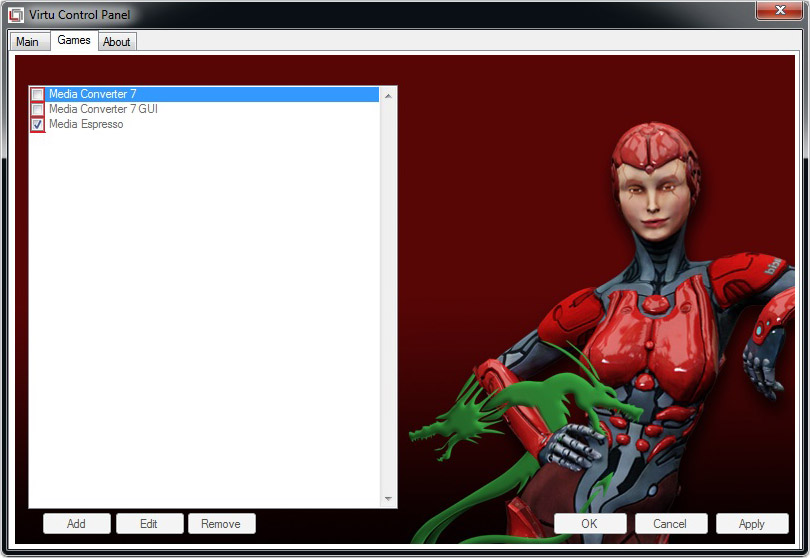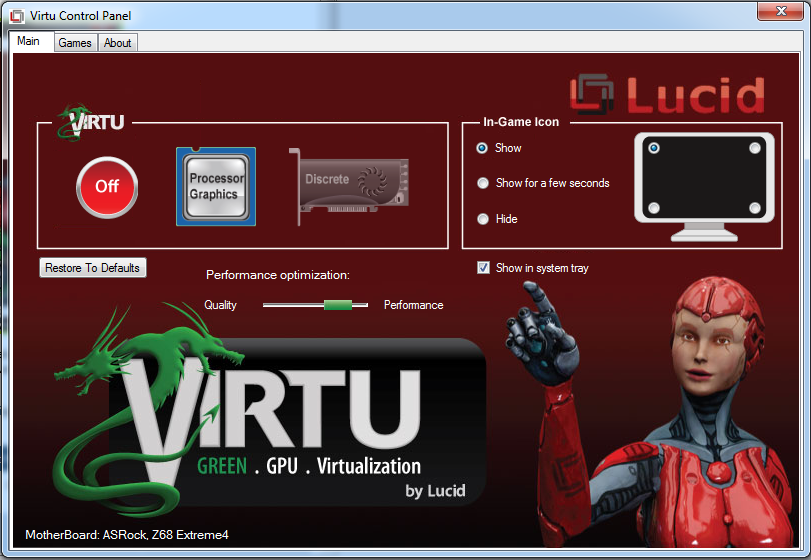Lucidlogix’s Virtu: Reclaiming Performance And Transcoding
In our earliest preview, Lucidlogix’s Virtu software allowed you to virtualize discrete graphics thorough Intel's HD Graphics frame buffer. This created a whole host of frankly inconvenient caveats. Natively, Intel's output is limited to 1920x1200. Moreover, games were only considered compatible once they were added to a white list of tested titles. And even then, there was a quantifiable performance hit attributable to overhead (check out this page of our Virtu preview for a deep-dive on how the software actually works).

Lucidlogix addressed all of our concerns in Virtu 1.0.105 by supporting discrete graphics natively, while virtualizing HD Graphics. This is a massive move forward. Instead of keeping track of a growing list games via the white list, you only have to keep track of one or two Quick Sync-enabled transcoding apps.
Really, nothing has really changed since our exclusive preview. Z68 motherboards are now shipping with Virtu v1.1.101, which seems to consist mainly of stability enhancements.
| Header Cell - Column 0 | Without Virtu Installed | With Virtu Installed |
|---|---|---|
| 3DMark 11 (3DMarks) | Overall: 3716GPU: 3499 | Overall: 3721GPU: 3499 |
| Crysis 21920x1080, Extreme Quality | 55.6 FPS | 55.2 FPS |
| Just Cause 21920x1080, High Quality, 8x AA/ 16x AF, Concrete Jungle | 48.15 FPS | 47.38 FPS |
| Word of Warcraft: Cataclysm1920x0180, Ultra Quality, DX11 | 87.9 FPS | 87.9 FPS |
We’ve already seen Lucidlogix deliver native gaming performance from discrete cards in discrete mode, so this is more of a spot check. With a GeForce GTX 460, we see no performance penalty when we install Virtu to enable HD Graphics virtualization. Just as it should be.
| ~600 MB Blu-ray Bonus Scene to iPad Profile | Without Virtu Installed, HD Graphics | With Virtu Installed, Discrete Graphics |
|---|---|---|
| Badaboom 2.0 | 49 seconds | Not Compatible |
| MediaConverter 7 | Not Compatible | Not Compatible |
| MediaEspresso 6.5 | 45 seconds | 46 seconds |
The three major media encoding applications that can take advantage of Quick Sync are MediaConverter, MediaEspresso, and Badaboom. By default, the first two programs are whitelisted by Virtu, but we can't get the latest version of MediaConverter 7 to transcode Blu-ray-quality video. For some reason, the progress bar stalls at 0%. This seems to be a glitch limited to our Z68 platform, which we hope will be solved quickly.
It's also interesting that we can leave our GeForce GTX 460 installed and, without Virtu, still run MediaEspresso natively by connecting our display to the motherboard's DVI port. Badaboom requires us to completely uninstall the Nvidia graphics card before we're able to transcode video through the Quick Sync engine.
Power Consumption
Get Tom's Hardware's best news and in-depth reviews, straight to your inbox.

| Power Consumption | IdleVirtu On | 31.2 GB Blu-ray H.264 Playback Virtu On / Off | IdleVirtu Off |
|---|---|---|---|
| Native HD GraphicsVirtualize Discrete Graphics | 81.2 W | 93.0 W | 81.1W |
| Native Discrete GraphicsVirtualize HD Graphics | 81.8 W | 104.8 W | 80.9 W |
| Native HD Graphics(no graphics card installed) | - | - | 63.0 W |
Lower power consumption was Lucidlogix's original aim in virtualizing discrete graphics. When you aren't gaming, you can disable the graphics card by clicking on the "Off" button. But this doesn't translate into using any less power. Disabling Virtu doesn't shut down the discrete graphics card; it only stops you from accessing its performance. In the meantime, the graphics card still consumes power while it's idle.
Virtualizing discrete graphics (and leaning on Intel's integrated solution) really matters when you're doing something like playing back video that the Quick Sync pipeline accelerates. Using HD Graphics natively, you access Intel's on-chip logic instead of Nvidia's, which requires less power than using a card like the GeForce GTX 460 just to access Nvidia's PureVideo decoder.
Current page: Lucidlogix’s Virtu: Reclaiming Performance And Transcoding
Prev Page SSD Caching Benchmarks: Real-World Next Page Virtu's Great, Caching Is Questionable-
LuckyDucky7 The Intel 311 might be one of the weirdest products I've seen for a while.Reply
It doesn't have an impact on games and apps which are too large to be cached and 60 GB drives that blow the 311 out of the water can be had for 20 bucks more.
And as far as getting QuickSync, it's about time. Should have been done in P67 (along with USB 3.0 support and 6 x SATA III ports) is all I can say. -
acku In an ideal world, that's what we should have seen, but Lucidlogix's Virtu really makes Z68 worth it.Reply -
ghnader hsmithot Sir and madam working at intel.You make us customers look retarded.Thank you.Reply -
Olle P mayankleoboy1is this realy the platform for enthusiasts? with almost daily news of lga2011 ... its a little bit hard to get too happy with thisYes it is!Reply
I am going to buy myself a Z68 mobo and a Core i5-2500K within a few weeks.
If you buy yourself an LGA2011 based platform we can get together a month from now and compare the results!
... or rather not, since it will take at least half a year for the 2011 to become available.
Let's face it. For at least a full month from now the Z68 will be the enthusiast platform.
Then AMD's competition will arrive, and we'll see how much of an option that is. -
acku hmp_gooseWhat is this "QuickSync"? My people do not have this word …Reply
http://www.tomshardware.com/reviews/sandy-bridge-core-i7-2600k-core-i5-2500k,2833-4.html -
ta152h A good comparison would have been striping hard disks to compare against caching with EEPROMs. You'd have more capacity, a lot more, and wouldn't have a technology that dies after a certain amount of writes, which is dubious to use for something that's being used as a cache, and written on rather consistently.Reply
Performance of Raid 0 would be higher than a single disk, and you'd be increasing performance without a loss in capacity (per dollar). Or, if you wanted the same capacity. you could get higher performance disks, and compare them that way.
If I want to spend an extra $100 to make my computer faster, will it? Duh, of course. That's all this article is saying. Is it the best way to spend that $100? Well, that much isn't clear at all. It wasn't compared with much of anything else. Two high capacity disks striped, and two higher performance disks (but lower capacity) striped, versus one disk and EEPROMs. All should be the same cost. It's more useful information. You'd have three fundamental choices - huge capacity, high "Winchester" performance, and low capacity with EEPROM caching. You could do a search on the capacity trade-offs pretty easily, but the performance difference between this caching and a high performance magnetic disk in RAID 0 is much less clear. Obviously, the hard disks would win a lot of tests, and could be a better buy for a lot of people.
It is worth looking at. -
Olle P Another little detail:Reply
Larsen Creek was the work name for Intel's SSD.
The final name now in use is Larson Creek, as can be easily read in the picture. -
flong Hey, did I read this right, the theoretical maximum of the 2600K and 2500k chips is 5.7 ghtz???? Has anyone ever got a cpu that high? The most Ive read about is 5.0 ghtz and that was with water cooling. So does 5.7 ghtz exist?Reply -
My GoD!Reply
Intels output is capped at 1920x1200? Below my native res! I've been forced to put my buy on hold...
What were they thinking?